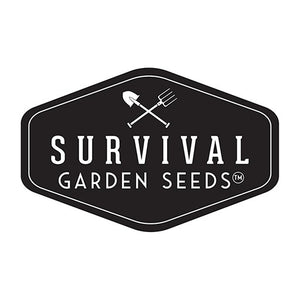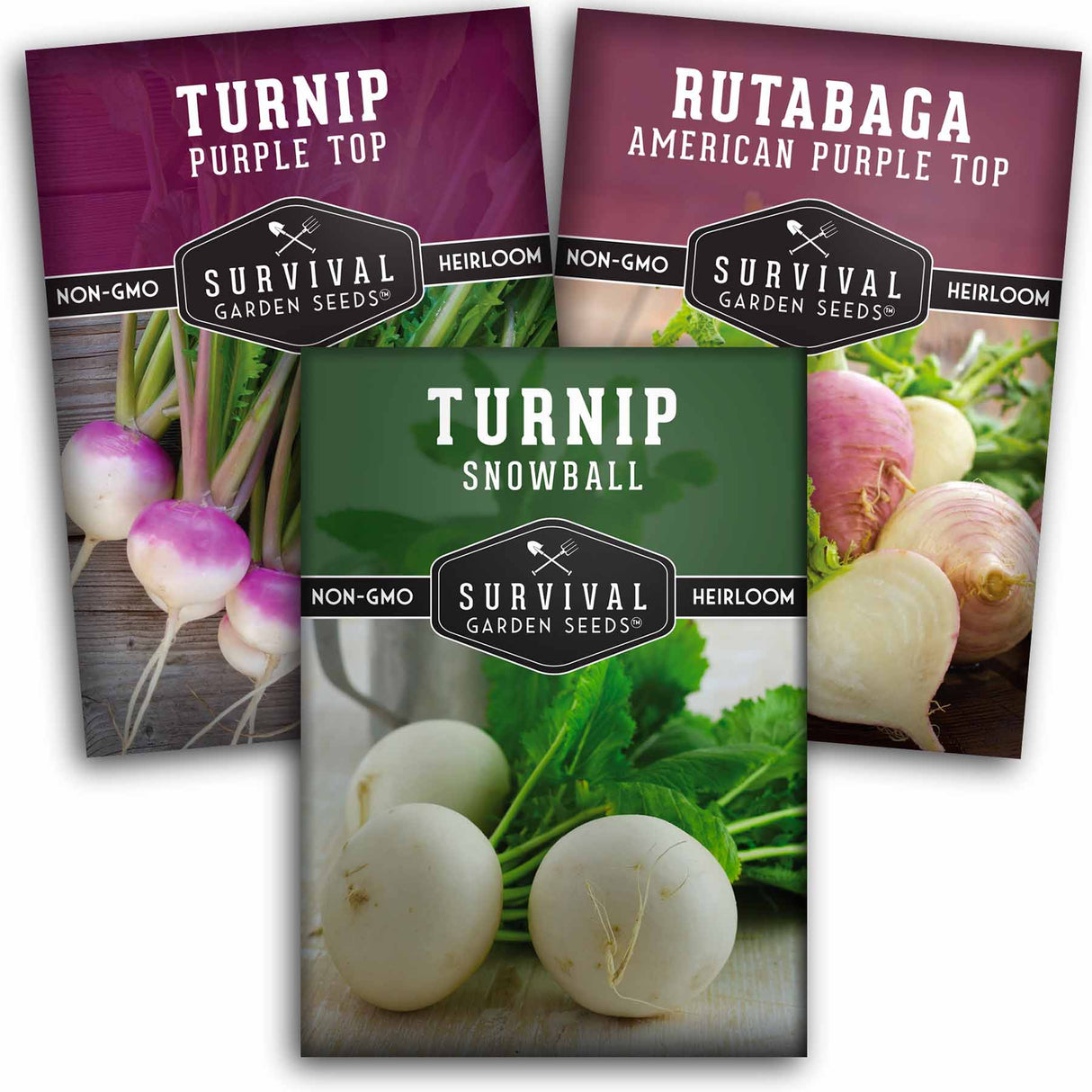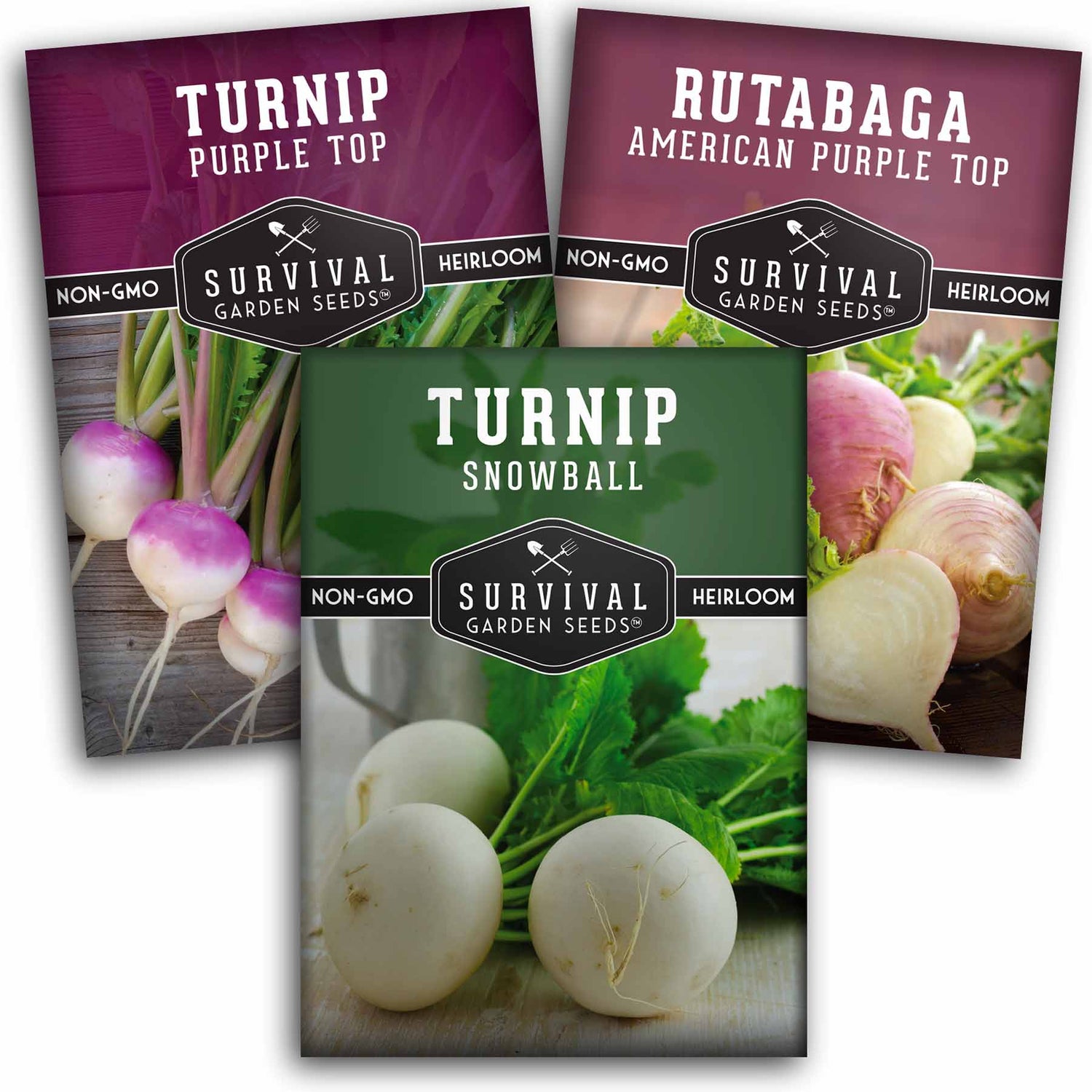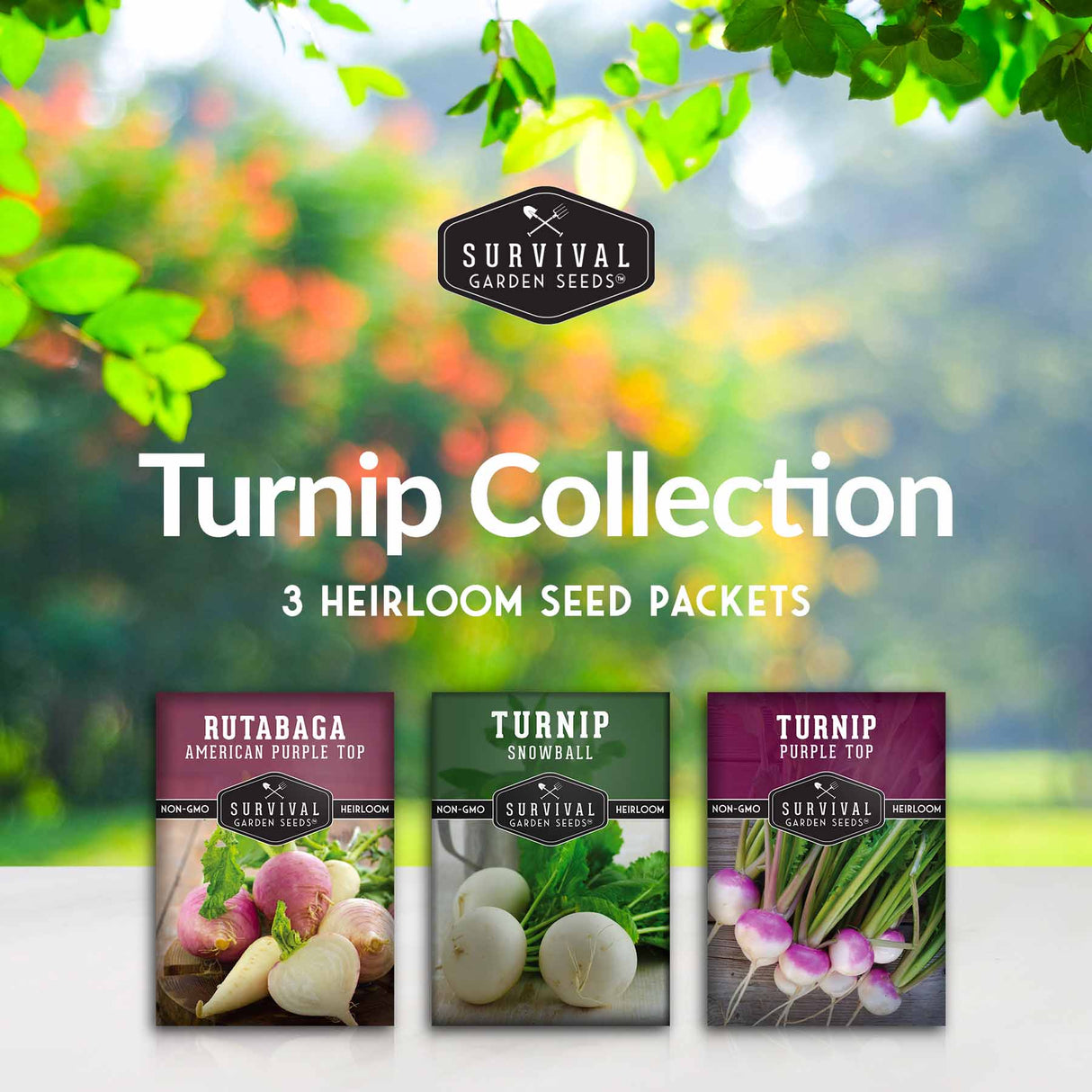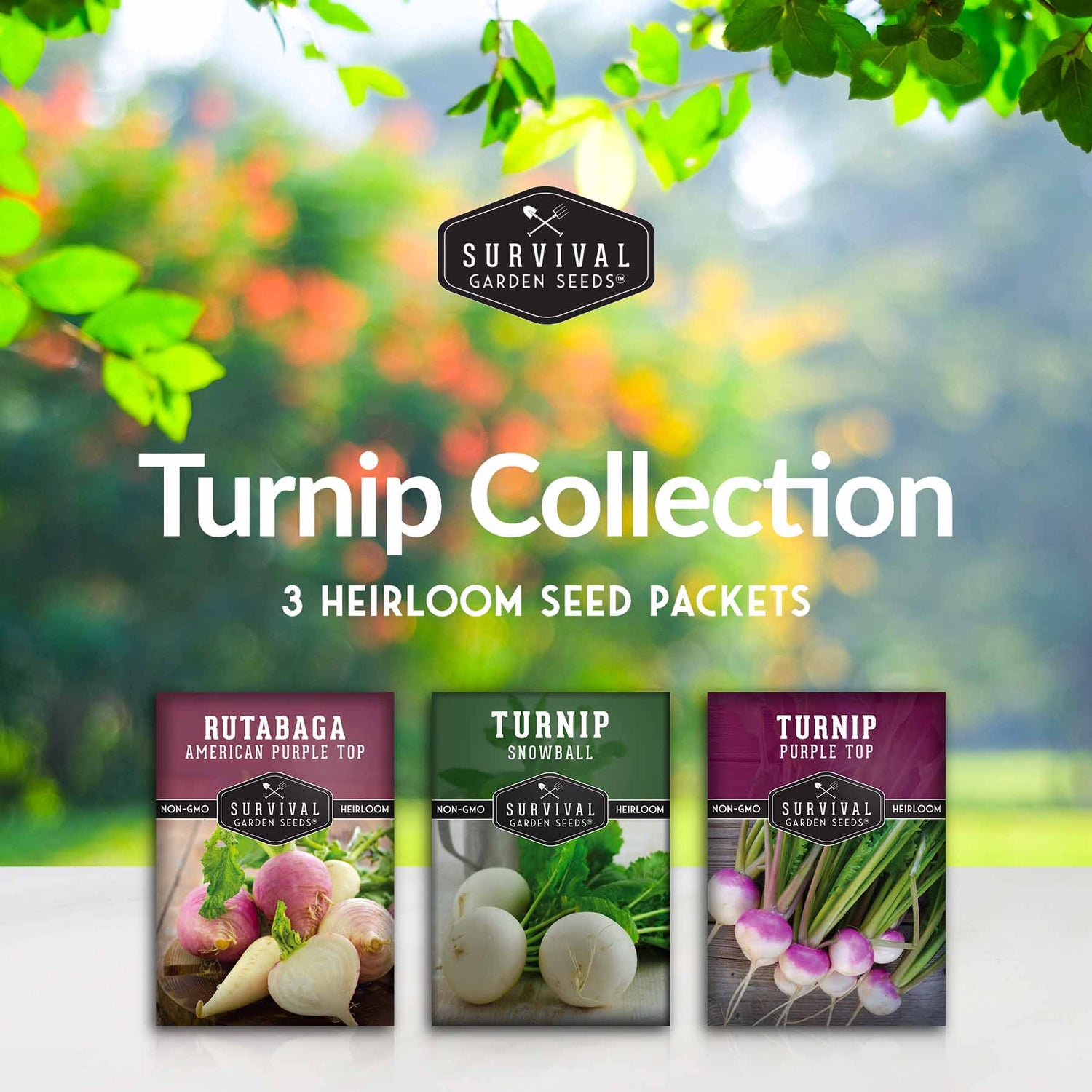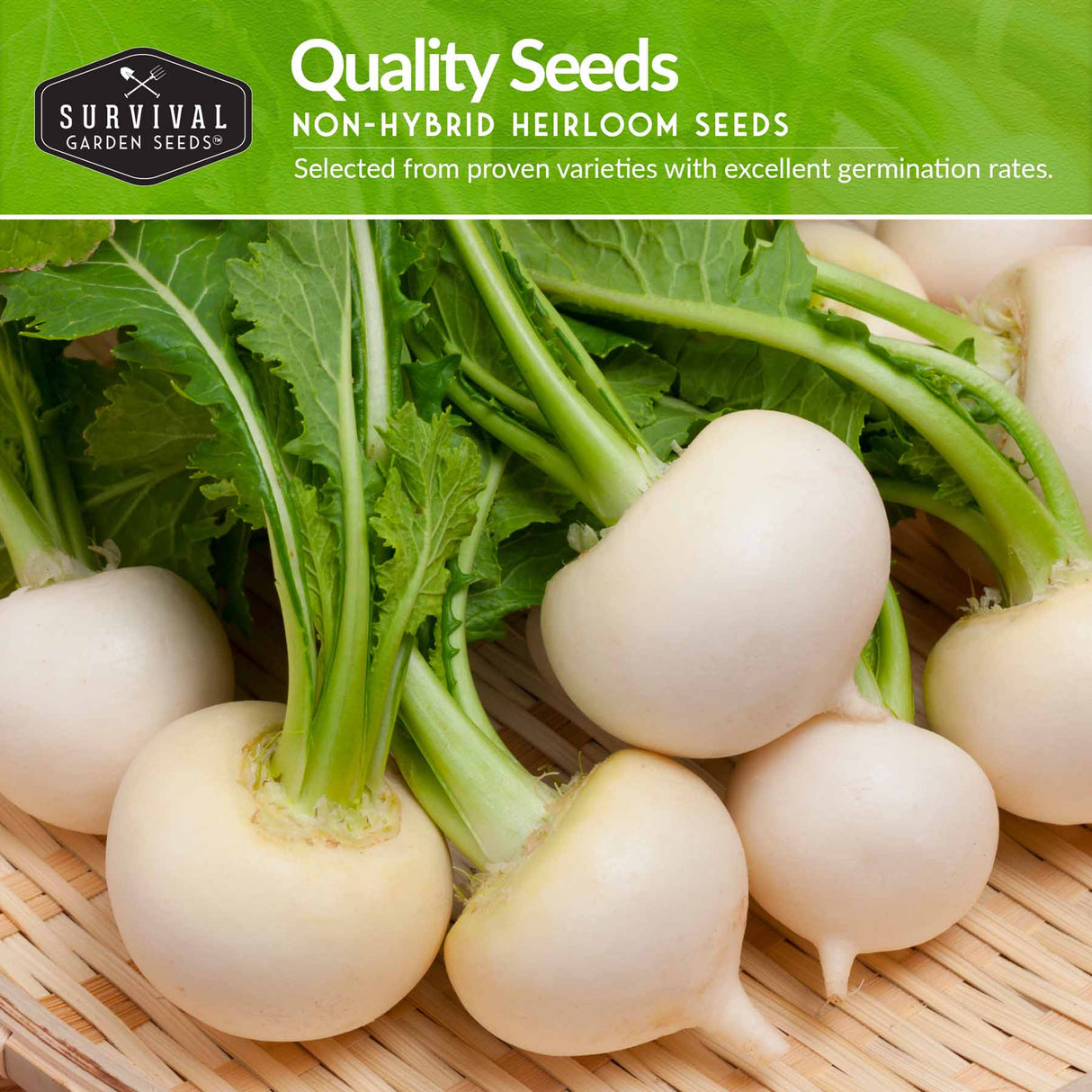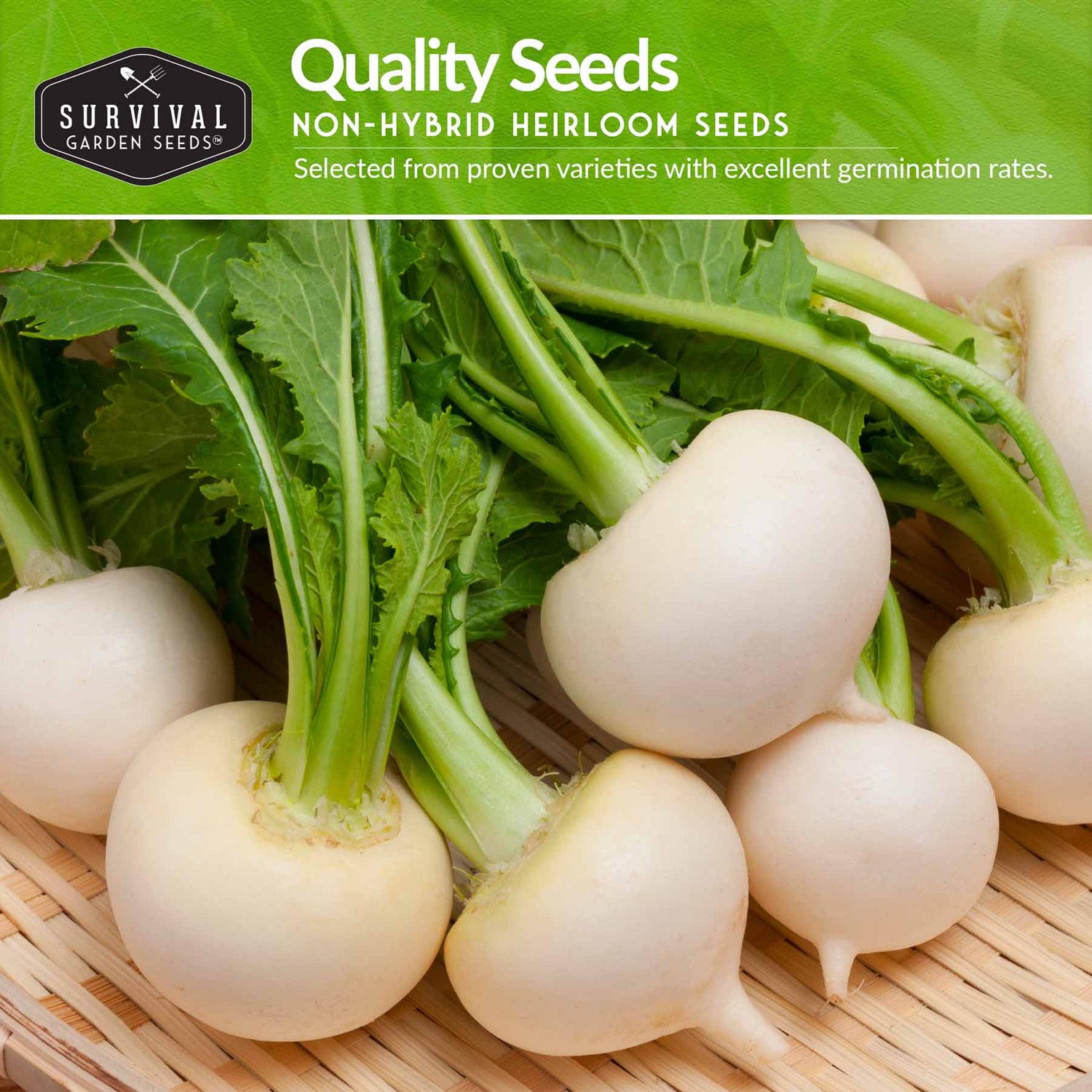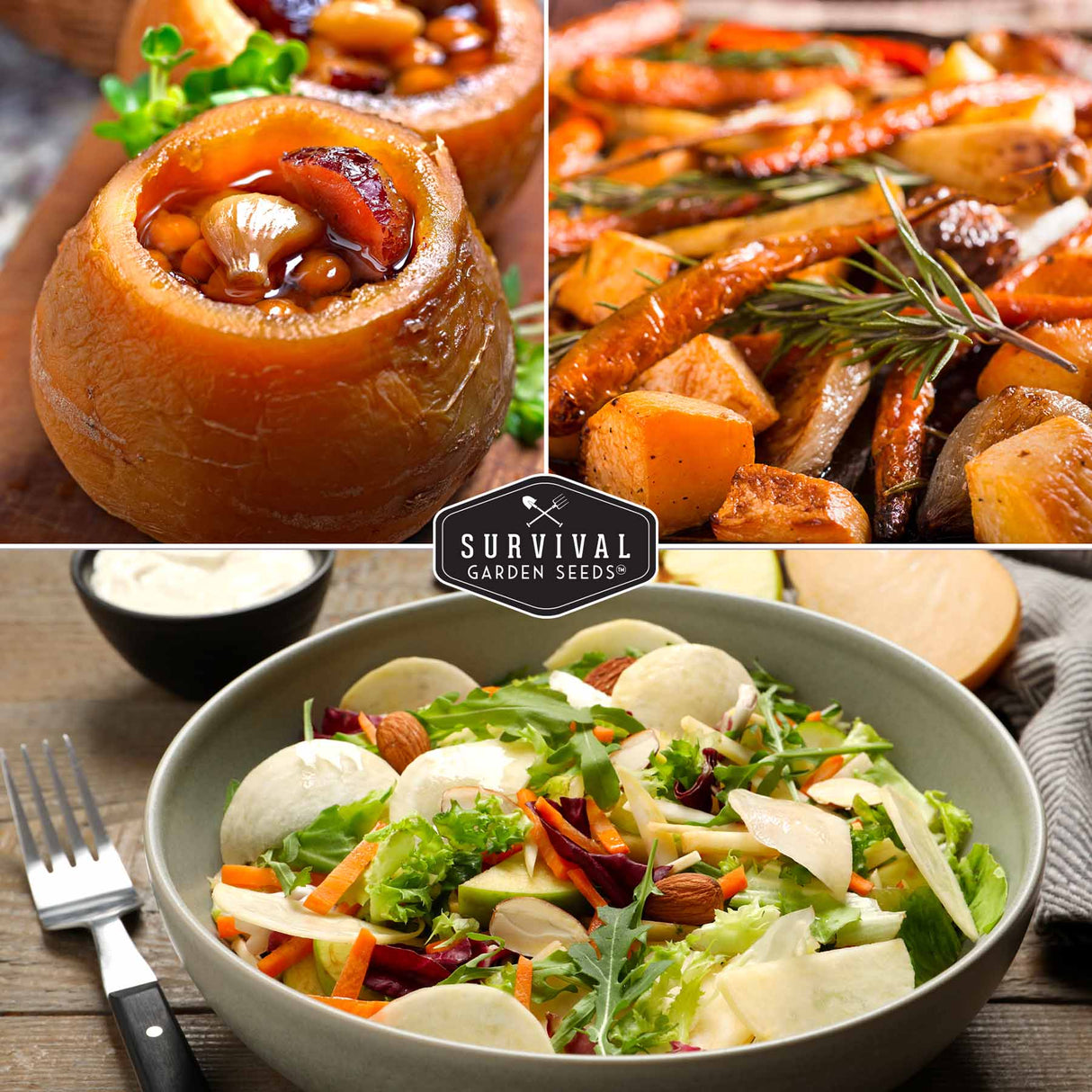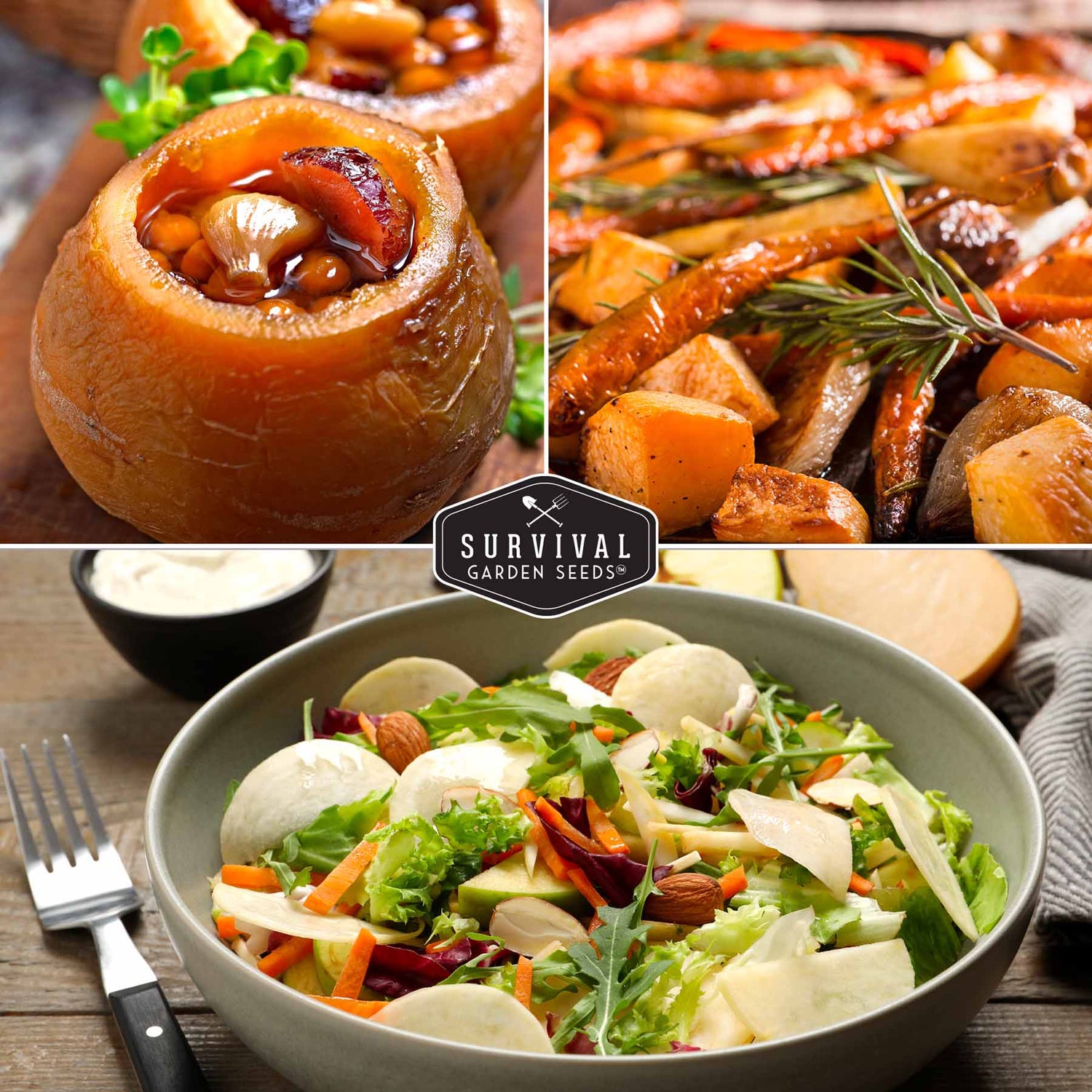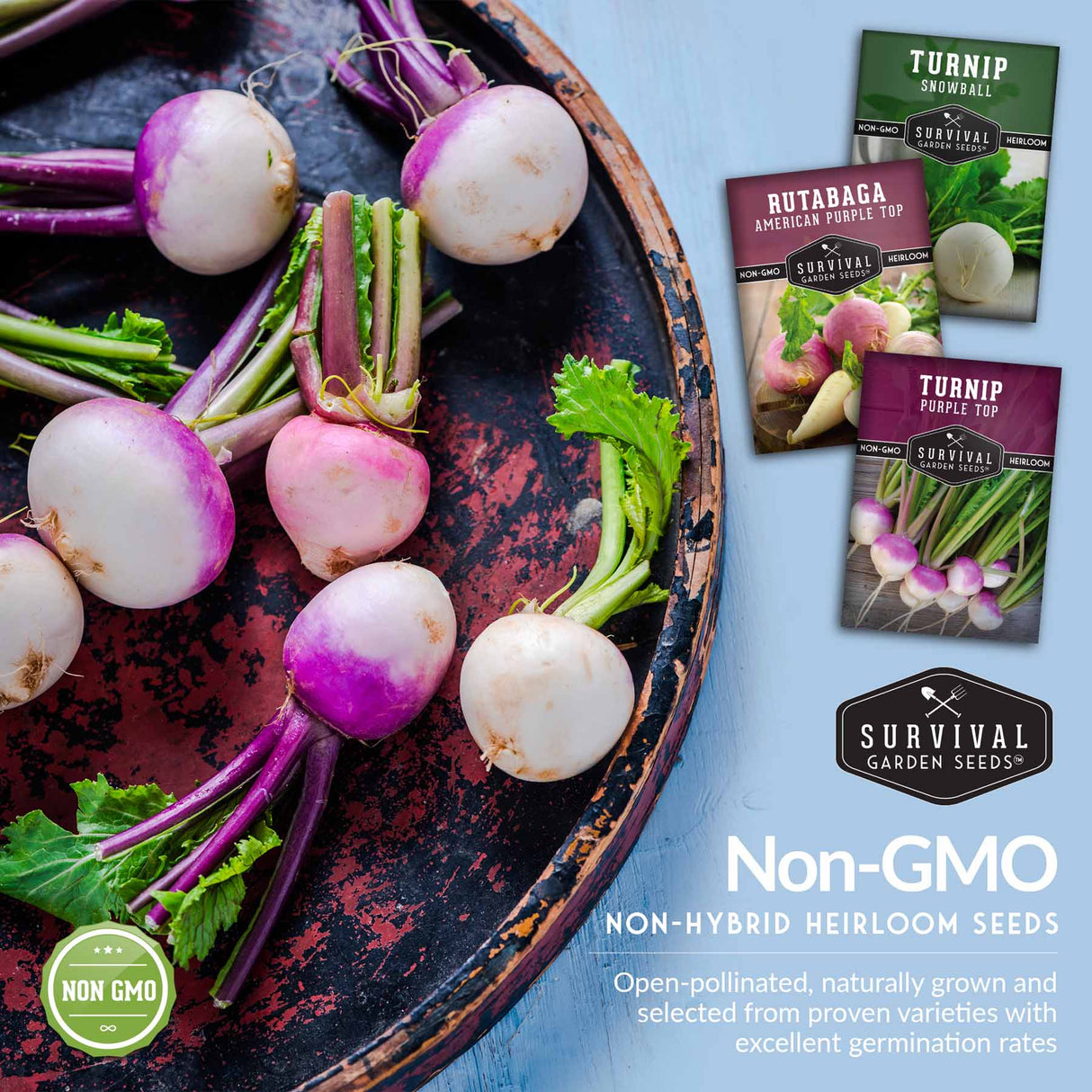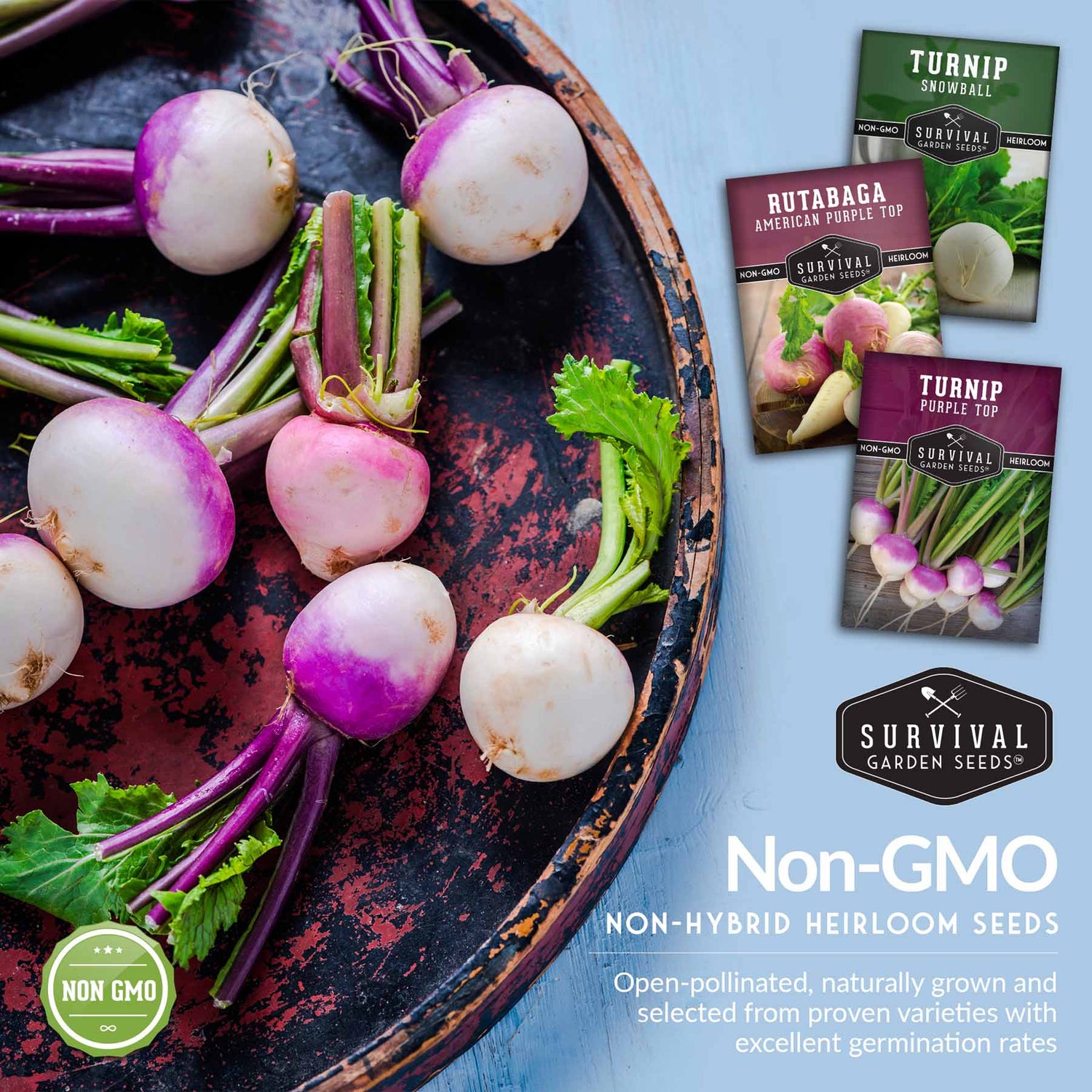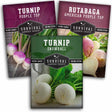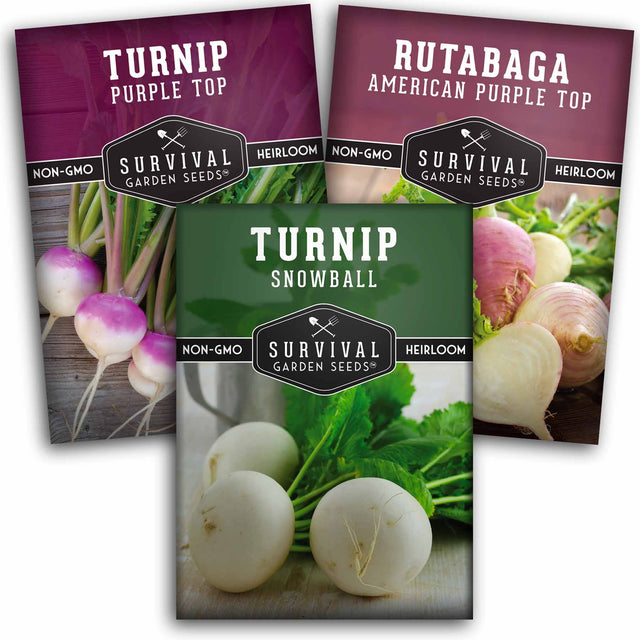Turnip & Rutabaga Seeds Collection – Heirloom Non-GMO Varieties for Fall & Spring Gardens
Heirloom - Non-GMO - Reliable Germination
Turnip & Rutabaga Seeds Collection – Heirloom Non-GMO Varieties for Fall & Spring Gardens is backordered and will ship as soon as it is back in stock.
Couldn't load pickup availability
Grow a diverse mix of nutritious root vegetables with the Turnip & Rutabaga Seeds Collection—a carefully selected heirloom trio featuring Purple Top Turnip, Snowball White Turnip, and American Purple Top Rutabaga. Each non-GMO variety offers dependable germination, cool-season resilience, and delicious results for both greens and roots. Ideal for backyard gardens, raised beds, or homesteads focused on year-round food security and self-reliance.
Versatile Cool-Season Collection:
Enjoy two planting opportunities each year—spring and fall—for a continuous supply of fresh greens and hearty storage roots. These easy-to-grow crops thrive in USDA Zones 3–9, making them suitable for most climates across the U.S.
Why Gardeners Love the Turnip & Rutabaga Collection:
- Three Classic Varieties: Includes Purple Top Turnip for tender greens and roots, Snowball White Turnip for mild, crisp texture, and American Purple Top Rutabaga for rich, golden storage roots.
- Dual-Purpose Harvests: Pick greens in 30–40 days or allow roots to mature in 50–65 days for late-season storage.
- Easy to Grow: Germinates in 5–10 days; performs well in full sun and well-drained soil.
- Adaptable Growing Options: Suitable for raised beds, garden rows, or container gardening.
- Reliable Heirloom Genetics: Open-pollinated, non-GMO seeds that can be saved for future planting.
How to Plant & Grow:
- When to Sow: Direct seed outdoors after the danger of frost has passed in spring, or 6–8 weeks before the first frost in fall.
- Soil & Light: Prefers cool weather, full sun, and fertile, well-drained soil.
- Spacing: Sow seeds ¼ inch deep; thin seedlings to 3–6 inches apart for best root development.
- Watering: Keep soil evenly moist to encourage uniform growth.
- Harvest: Pick young greens early or allow roots to mature before the ground freezes.
Harvest & Use:
- Turnip Greens: Tender and flavorful when harvested young, great for sautés or soups.
- Turnip & Rutabaga Roots: Excellent roasted, mashed, or added to stews; store well through winter for extended use.
This collection contains 3 packets of seeds including:
Snowball Turnip (pkg.wt. 400mg) also known as Tokyo turnip, is a small, white turnip with a mild, sweet flavor. It is often eaten raw in salads or pickled, but can also be roasted or sautéed.
Purple Top Turnip (pkg.wt. 750mg) is a larger turnip with a purple and white coloration. It has a slightly spicy flavor and a denser texture than the Snowball Turnip. Purple Top Turnips are often roasted, mashed, or used in soups and stews.
American Purple Top Rutabaga (pkg.wt. 500mg) is a root vegetable that is a cross between a turnip and a cabbage. It has a yellow flesh and a purple and white skin. The flesh is sweet and nutty, with a slightly bitter aftertaste.
Heirloom Garden Seeds
All of our seeds are open-pollinated, non-GMO, heirloom varieties with tested germination rates
Payment & Security
Payment methods
Your payment information is processed securely. We do not store credit card details nor have access to your credit card information.
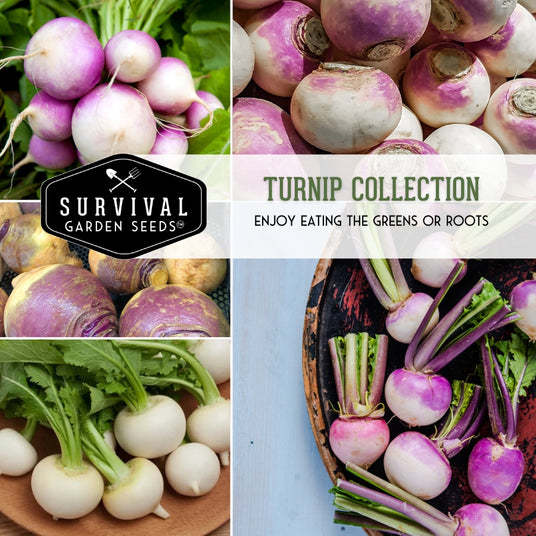
Tasty Root Vegetables
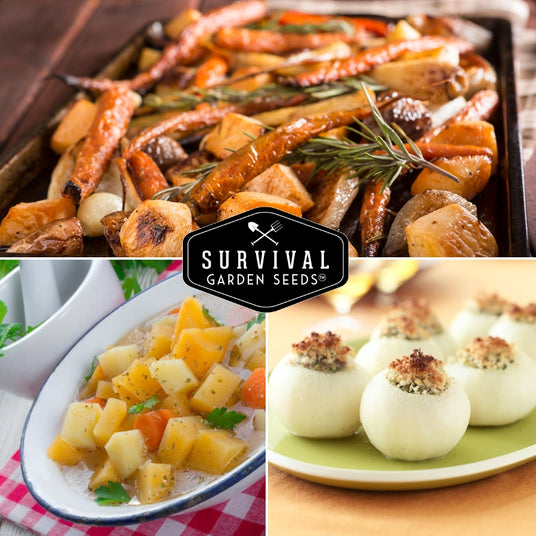
Cool-Season Crop
Why Choose Survival Garden Seeds
At Survival Garden Seeds, we believe in preparing today for tomorrow’s peace of mind. That’s why we offer only heirloom, non-GMO, and untreated seeds you can trust to nourish your family and support a sustainable lifestyle. As a family-owned American company, we’re committed to providing seeds that grow strong and true—helping you cultivate health, resilience, and beauty in your garden.
Frequently Asked Questions
What are heirloom seeds?
What are heirloom seeds?
Heirloom seeds are the types of seeds your grandparents grew. These varieties have been passed down from generation to generation. They’re old reliable open-pollinated varieties that aren’t typically grown commercially. Instead, they have a rich history that predates modern breeding techniques.
You can learn more about open-pollinated, heirloom, and non-GMO seeds in our Survival Garden Training blog.
How do I know my seeds are fresh?
How do I know my seeds are fresh?
Every seed packet includes a "packed for" date, and we germination test each seed lot before packaging to ensure you receive viable, high-quality seeds that are ready to grow.
Are your seeds treated?
Are your seeds treated?
No, we do not pre-treat our farmer seeds. All of our garden seeds for sale are untreated, open-pollinated, non-GMO, and heirloom varieties. They are kept in temperature-controlled cooler storage until they are packed and shipped to keep them pest and disease-free.
In what zones can I grow your seeds?
In what zones can I grow your seeds?
The seeds in our collections are specifically chosen from varieties that can be successfully grown from Zone 3 to Zone 10 USDA Hardiness Zones. However, individual varieties have specific needs to thrive in different environments. Each seed pack has optimal temperatures for germination and instructions on seed starting. Consult local frost dates to plan your garden and get the most out of your seeds.
What is the shelf life of these gardening seeds?
What is the shelf life of these gardening seeds?
Most seeds remain viable for 3 to 5 years or longer when stored properly. Check your seed packet for specific varieties. For best results, keep your seeds in a cool, dry place away from direct sunlight and moisture. Store them in an airtight container in a consistent temperature environment—a refrigerator or cool basement works well. Proper storage helps maintain germination rates and extends seed life well beyond the packed date.
Where are Survival Garden Seeds sourced?
Where are Survival Garden Seeds sourced?
The majority of our seeds are sourced in the United States, with a few exceptions when the seed is difficult to source domestically. Whenever we do have to source outside of the US, we ensure our seeds are safe to grow, non-GMO varieties that meet our standards for germination and reliability.
